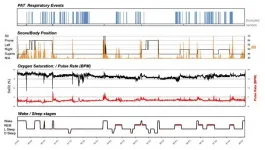Individualized training is key for autistic adolescents learning to drive
Specialized driving instructors say path to getting licensed for autistic teens may be longer, but achievable with tailored instruction and other support
2021-04-20
(Press-News.org) Philadelphia, April 20, 2021 - A collaborative study from the Center for Injury Research and Prevention (CIRP) and the Center for Autism Research (CAR) at Children's Hospital of Philadelphia (CHOP) identified clear strengths and a series of specific challenges autistic adolescents experience while learning to drive. The findings were recently published by the American Journal of Occupational Therapy.
Researchers conducted in-depth interviews with 17 specialized driving instructors who were trained as occupational therapists, driving rehabilitation specialists, or licensed driving instructors and who had completed additional training related to teaching autistic individuals to drive. Their insights stress the importance of providing specialized, scaffolded instruction where skills are taught one at a time, allowing students to develop mastery before adding new skills. These approaches help young autistic drivers develop driving skills over time supported by plenty of caregiver-supervised practice.
Instructors described specific behind-the-wheel challenges among young autistic drivers, including being overly rule-bound, becoming easily distracted, and having difficulty integrating what other drivers are doing with their own hand-eye-foot coordination required to drive. Instructors believed many of these challenges could be overcome through careful skill-building instruction over a prolonged period of time.
Observed strengths of young autistic drivers included carefully following the rules of the road, paying close attention to their driving environment, and limiting risk-taking. Instructors believed these clear strengths help students become competent drivers.
"Through our interviews with specialized driving instructors who worked specifically with young autistic drivers, we learned about teaching strategies perceived to be effective and recommendations to improve the learning-to-drive process for these adolescents and young adults," said Rachel K. Myers, PhD, lead author of the study and a scientist at CIRP. "Rigorous, individualized training is needed for their behind-the-wheel instruction. More research is needed to standardize best practices for autistic adolescent driver instruction."
Besides breaking down driving tasks into discrete learning goals, instructors used a variety of strategies to build driving skills, including having teens sit in the passenger seat and describe what the driver is doing, and repeated practice on the same driving routes to reduce anxiety.
Instructors also stressed that young autistic drivers should be prepared for experiences they may encounter outside the vehicle, such as changing a tire or interacting with law enforcement. After getting licensed, some instructors may recommend autistic adolescents drive only with supervision or restrictions, such as only traveling on familiar routes.
"According to the specialized driving instructors we interviewed, autistic adolescents who had limited experience with other forms of transportation or vehicle use, such as bicycling, before learning to drive had a harder time learning to control the vehicle," said Benjamin E. Yerys, PhD, study author and a clinical psychologist at CAR. "This difficulty could contribute to challenges in controlling speed, maintaining lane position, and managing oncoming traffic. Caregivers should find ways to promote these life skills and hand-eye-foot coordination skills before beginning the learning-to-drive process."
Recent research conducted at CHOP found that newly licensed young autistic drivers have similar to lower crash rates than their non-autistic peers. Additionally, young autistic drivers are much less likely to have their license suspended or to receive a traffic violation than their non-autistic peers.
Driving is an important part of leading an independent life and is one option for ensuring safe mobility for autistic adolescents and young adults. Resources for families to help with the transition to adulthood are available at TeenDriverSource.org and CAR Autism Roadmap.
INFORMATION:
This work was supported by the Eunice Kennedy Shriver National Institute of Child Health and Human Development at the National Institutes of Health.
Myers et al, "Behind the Wheel: Specialized Driving Instructors' Experiences and Strategies for Teaching Autistic Adolescents to Drive." Am J Occup Ther, online April 12, 2021. DOI: 10.5014/ajot.2021.043406.
About Children's Hospital of Philadelphia: Children's Hospital of Philadelphia was founded in 1855 as the nation's first pediatric hospital. Through its long-standing commitment to providing exceptional patient care, training new generations of pediatric healthcare professionals, and pioneering major research initiatives, Children's Hospital has fostered many discoveries that have benefited children worldwide. Its pediatric research program is among the largest in the country. In addition, its unique family-centered care and public service programs have brought the 595-bed hospital recognition as a leading advocate for children and adolescents. For more information, visit http://www.chop.edu.
ELSE PRESS RELEASES FROM THIS DATE:
2021-04-20
Flushing a toilet can generate large quantities of microbe-containing aerosols depending on the design, water pressure or flushing power of the toilet. A variety of pathogens are usually found in stagnant water as well as in urine, feces and vomit. When dispersed widely through aerosolization, these pathogens can cause Ebola, norovirus that results in violent food poisoning, as well as COVID-19 caused by SARS-CoV-2.
Respiratory droplets are the most prominent source of transmission for COVID-19, however, alternative routes may exist given the discovery of small numbers of viable viruses in urine and stool samples. Public restrooms are especially cause for concern for transmitting COVID-19 because they are ...
2021-04-20
A new UCLA study finds that the proportion of physicians who are Black in the U.S. has increased by only 4 percentage points over the past 120 years, and that the share of doctors who are Black men remains unchanged since 1940.
The research also spotlights a significant income gap between white and Black male physicians -- a disparity, the researcher writes, that could reflect a combination of pay discrimination and unequal access for physicians to pursue careers in more lucrative specialties. The paper will be published April 19 in the peer-reviewed Journal of General Internal Medicine.
"These findings demonstrate how slow progress has been, and how far and fast we have to go, if we care about the diversity of the physician workforce and the health benefits such diversity brings ...
2021-04-20
COLUMBUS, Ohio - A high daily dose of an omega-3 supplement may help slow the effects of aging by suppressing damage and boosting protection at the cellular level during and after a stressful event, new research suggests.
Researchers at The Ohio State University found that daily supplements that contained 2.5 grams of omega-3 polyunsaturated fatty acids, the highest dose tested, were the best at helping the body resist the damaging effects of stress.
Compared to the placebo group, participants taking omega-3 supplements produced less of the stress hormone cortisol and lower levels of a pro-inflammatory protein during a stressful event in the lab. And while levels of protective compounds sharply declined in the placebo group after the stressor, there were ...
2021-04-20
A Monash University study has uncovered for the first time a way to prevent and reverse damage caused by broken-heart syndrome, also known as Takotsubo cardiomyopathy.
Using mouse models, the pre-clinical study published in the acclaimed journal Signal Transduction and Targeted Therapy, has shown the cardioprotective benefit of a drug called Suberanilohydroxamic acid, or SAHA, dramatically improved cardiac health and reversed the broken-heart. The landmark study used SAHA to target genes and is a world first for Takotsubo cardiomyopathy.
SAHA, currently used for cancer treatment, is approved by the US Food and Drug Administration (FDA) and Australian Therapeutic Goods Administration (TGA), works by providing a protective benefit to genes and ...
2021-04-20
For the first time, a study has shown a clear link between the frequency and duration of unconscious wakefulness during night-time sleep and an increased risk of dying from diseases of the heart and blood vessels, and death from any cause, particularly in women.
The study of 8001 men and women, which is published today (Tuesday) in the European Heart Journal [1], found that women who experienced unconscious wakefulness most often and for longer periods of time had nearly double the risk of dying from cardiovascular disease during an average of between 6 and 11 years' ...
2021-04-20
Taking multivitamins, omega-3, probiotics or vitamin D supplements may lessen the risk of testing positive for SARS-CoV-2, the virus responsible for COVID-19 infection--at least among women--indicates a large population study, published online in the journal BMJ Nutrition Prevention & Health.
But taking any of vitamin C, zinc, or garlic supplements wasn't associated with a lower risk of testing positive for the virus, the findings show.
There has been plenty of celebrity endorsement of the use of dietary supplements to both ward off and treat COVID-19 infection since the start of the pandemic, note the researchers.
In the UK alone, market share ...
2021-04-19
Nanochannels have important applications in biomedicine, sensing, and many other fields. Though engineers working in the field of nanotechnology have been fabricating these tiny, tube-like structures for years, much remains unknown about their properties and behavior.
Now, University of Maryland mechanical engineering associate professor Siddhartha Das and a group of his Ph.D. students have published surprising new findings in the journal ACS Nano. Using atomic-level simulations, Das and his team were able to demonstrate that charge properties as well as charge-induced fluid flow within a functionalized nanochannel does not always behave as expected.
"We've discovered a new context for nanochannels functionalized by grafting ...
2021-04-19
One of the marks of a successful idea in science is how quickly it can develop and evolve. In the case of the Anthropocene, the conceptual evolution has taken place with extraordinary speed. The strikingly influential hypothesis launched by the late Nobel laureate Paul Crutzen (Obituary, 24th Feb 2021) in 2000, was that the actions of an industrialised humanity has impacted the Earth so greatly as to trigger a new geological epoch. Originally developed within the Earth System science community in charting global environmental change, the Anthropocene then began ...
2021-04-19
April 19, 2021 -- Ensuring COVID-19 vaccine access for refugee and displaced populations, and addressing health inequities, is vital for an effective pandemic response. Yet, vaccine allocation and distribution has been neither equitable nor inclusive, despite that global leaders have stressed this as a critical aspect to globally overcoming the pandemic, according to a paper published by Columbia University Mailman School of Public Health. Read "Leave No-one Behind: Ensuring Access to COVID-19 vaccines for Refugee and Displaced Populations" in the journal Nature Medicine.
As of April 1st, high and upper-middle-income countries received 86 percent of the vaccine doses delivered worldwide, while ...
2021-04-19
Tools that allow neuroscientists to record and quantify functional activity within the living brain are in great demand. Traditionally, researchers have used techniques such as functional magnetic resonance imaging, but this method cannot record neural activity with high spatial resolution or in moving subjects. In recent years, a technology called optogenetics has shown considerable success in recording neural activity from animals in real time with single neuron resolution. Optogenetic tools use light to control neurons and record signals in tissues that are genetically modified ...
LAST 30 PRESS RELEASES:
[Press-News.org] Individualized training is key for autistic adolescents learning to drive
Specialized driving instructors say path to getting licensed for autistic teens may be longer, but achievable with tailored instruction and other support


